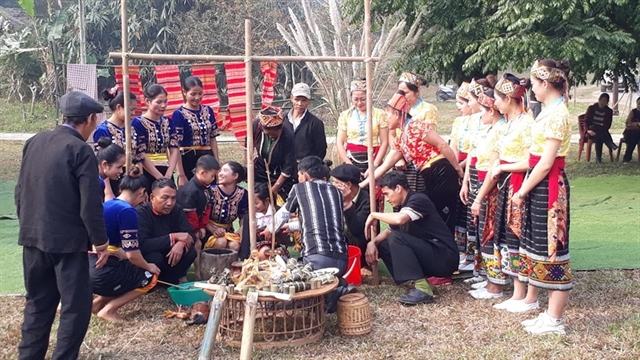HÀ NỘI – The spring atmosphere will overwhelm the Việt Nam Ethnic Village of Culture and Tourism throughout January with various festivals of ethnic minority groups throughout the nation.
Around 100 people from 13 ethnic minorities including Nùng, Tày, Mông, Dao, Mường, Thái, Khơ Mú, Tà Ôi, and Ba Na will join the funfairs.
Folk games, handicraft performances, and traditional cuisine will be featured during weekdays and weekends.

Various spring festivals of many ethnic minority groups will be showcased at the Việt Nam Ethnic Village of Culture and Tourism throughout January. VNS Photo Trần Quang Thành
Groups from Thái Nguyên, Hà Nội, Gia Lai, Đăk Lắk and Sóc Trăng will show off daily routines together with around 20 people from the Thái team from the northern province of Sơn La between January 22 and 23.
Funfairs of the month named 'Mountainous Region’s Spring Fragrance', will highlight ethnic hand-loom weaving skills at the common house while the special activity under the theme 'Mountainous Region’s Spring Colours' includes Hạn Khuống ceremony hosted by the Thái group from the northern province of Sơn La.
The ceremony is a relaxing time, which often takes place in November, after the rice harvest. People enjoy various community activities like singing, dancing and telling stories.
Xòe dance of the Thái, which is also known as xe khăm khen (hands in hands dancing) will be performed. The dance expresses solidarity, democracy and collectiveness of Thái people. The dance has just been added to the list of Intangible Cultural Heritages of Humanity by the United Nations' cultural agency UNESCO.
The group dance xòe at spring festivals, crop festival and weddings, which has been considered a cultural symbol of the northwest region.
There are three main types of xòe – ritual, circle and presentational.
The ritual and presentational xòe dances are named after props used during certain performances. For example, there is xòe khăn (dance with scarfs), xòe nón (dance with conical hats), xòe quạt (dance with hand fans), xòe sạp (dance with bamboo poles), xòe nhạc (dance with music), xòe gậy (dance with sticks), and xòe hoa (dance with flowers).
The most popular form is circle xòe, where dancers form a circle and perform in harmony. The basic movements include raising and opening the hands, then lowering them and clasping the hands of the adjacent person. The dancers follow rhythmic footsteps, slightly arching the chest and leaning backwards. Although simple, the dance movements symbolise wishes for community health and harmony.
Xòe dance is accompanied by various musical instruments, including tính tẩu (gourd lutes), kèn loa (a kind of trumpet), drums, gongs, cymbals and reed flutes. The instrumental music blends with the vocals and the jingling sound of the silver jewellery accessories wearing around the waists of the female dancers.
Decorations for Tết (traditional Lunar New Year) can be found at houses on stilts in the village with fruit trays, bonsai, national flags, portraits of President Hồ, where visitors can experience spring festival of ethnic groups.
The village locates in Đồng Mô District, some 45km to the west of Hà Nội’s centre. VNS
OVietnam